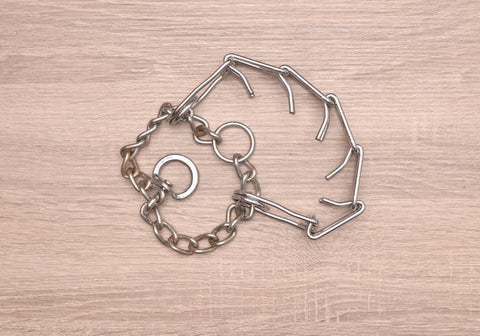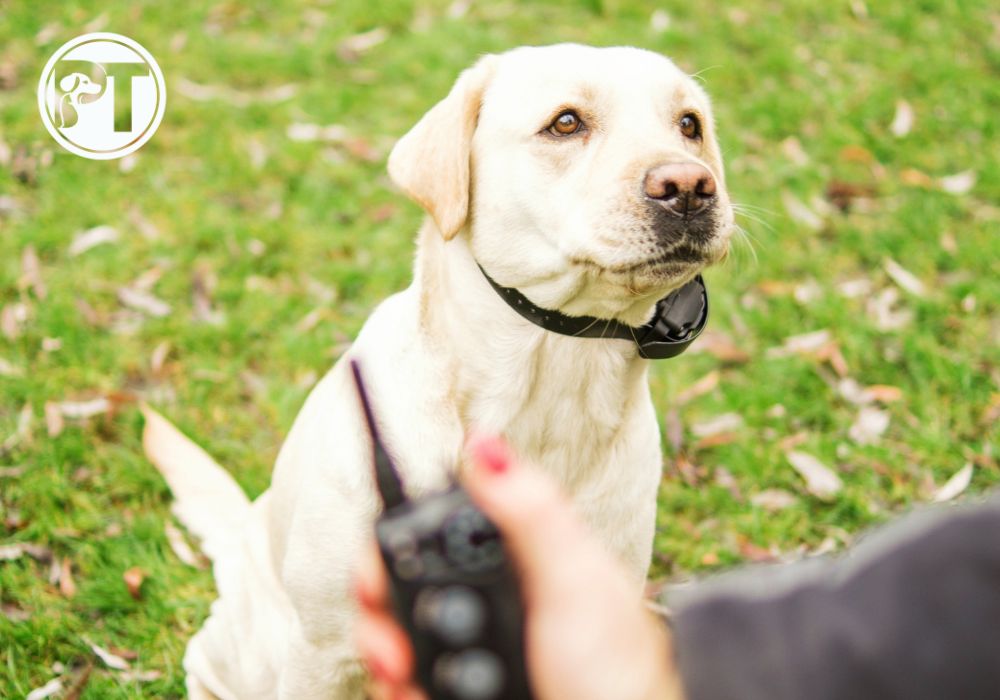Positive Reinforcement vs Balanced Dog Training – Pros, Cons & Tools

Positive reinforcement has a nice ring to it. Balanced dog training, maybe not so much. What does it even mean?
Dog training methods can be a controversial topic, especially for techniques that some may deem “aversive.” While this may seem like going out on a limb, it’s high time the arguments from both sides be heard as objectively as possible.
In theory, positive reinforcement in dog training may be the most effective method dog owners and trainers can use. In practice, it might not hold up to real-world situations and demands.
Before diving deep into these training methods, it’s important to look back at where they originated.
The Four Quadrants of Operant Conditioning
During the early 1900s, behavioral psychologist B.F. Skinner argued that you could learn a new behavior due to the consequences of that behavior. And these consequences could affect your future conduct or actions. This is known as operant conditioning learning theory, structured on reinforcement and punishment as behavioral consequences.
Skinner’s reinforcement and punishment are each classified into positive and negative, which make up the four quadrants of operant theory:
- Positive Reinforcement - adding a reward (positive) to reinforce the desired behavior and increase its chances of being repeated again
- Negative Reinforcement - removing an unpleasant stimulus (negative) to make the desired behavior more likely to happen in the future
- Positive Punishment - adding an undesirable consequence (positive) to eliminate unwanted behavior
- Negative Punishment - removing a pleasant stimulus to discourage undesirable behavior

These four quadrants of operant conditioning are widely applied in dog training today. Positive reinforcement and balanced dog training are two such techniques that incorporate Skinner’s operant learning theory.
What is Positive Reinforcement Training?

Positive reinforcement is a reward-based dog training method. This type of training uses rewards to strengthen desirable behaviors. Rewards can be what your dog likes, such as treats, praise, or toys.
Positive dog trainers delight themselves in promoting all-positive training methods to teach behavior. If your dog does something right, they give them rewards. And if your pet does otherwise, they withhold rewards without any punishment.
However, if you take a second look at it, it’s actually punishing dogs through negative punishment. Withholding rewards, which your dog likes, falls on the fourth quadrant. But of course, it’s not what some people mean when they say “no punishment.” They refer to training tools that they regard as “physically painful,” “terrifying,” and “inhumane” to dogs.
But are these tools truly harmful to dogs?
Does Positive Reinforcement Really Work?
There’s some truth to why many dog trainers advocate using rewards in training dogs. It’s effective. Positive reinforcement training works wonders in teaching your dog some cool tricks like fetch or high-five. It’s also great for basic obedience lessons, like getting your pooch to sit, stay, down, come, and heel.
Positive trainers have proven that all-positive training is perfect for teaching your dog new commands and reinforcing good behavior.
Limitations of Positive Reinforcement in Dog Training

Positive reinforcement means saying “Yes!” every time your dog behaves correctly, but not saying “No!” when they misbehave. Why? In positive training, you don’t correct the undesirable behavior but only ignore it when this happens.
A force-free training method, as some people like to call it, cannot stop your dog from doing something problematic and dangerous, like lunging at other dogs or people. But you can’t just ignore them when this happens and wait for them to cool down or behave.
What if your dog bolts and chases a squirrel down the street? Do you think a high-valued treat or simple recall would suffice? In all honesty, you don’t know. The squirrel may be too great of a distraction than the treat your pet likes. Don’t let that uncertainty lead to unforeseeable accidents, God forbid, only because you think treats are enough. Positive reinforcement is excellent in encouraging good behavior, but more often than not, it doesn’t work if you want to stop unwanted behavior pronto.
Pros of Positive Reinforcement Training
- Easy and uncomplicated. Just reward good behaviors to see them more often.
- Fun and engaging. It uses your dog’s favorite motivator (treats, toys, or praises) to encourage them to learn a trick or command.
- Instills willingness in your dog to look forward to the next training session
- Fosters trust and a lasting bond between you and your dog
- Does not employ discomfort during training
- Can be done anytime and anywhere. Grab a bag of goodies and a clicker, and you’re good to go.
Cons of Positive Reinforcement Training
- Your dog may only listen to you if you have treats and not when you don’t.
- There is a risk of your dog getting obese due to high-calorie intake from food or treats.
- Withholding treats frustrates your dog, leading them to act out.
- Your dog might get bored during longer training sessions.
- Training can take much longer for complex tricks or commands.
- There may be a lack of clear communication when your dog is off-leash or distracted.
- It doesn’t work well in stopping undesirable behavior, such as aggression, chasing a small animal, or jumping on people.
What is Balanced Dog Training?

As the name implies, balanced dog training means a balanced approach to training your dog, especially in modifying behaviors. This type of dog training employs all four quadrants of operant learning theory. This means positive reinforcement is also an essential component of this training technique. So, if your dog does something good, they get a reward by giving something they like or removing something they dislike. But if your dog does something undesirable, they get a correction, or something pleasant is removed.
While it is true that balanced training uses punishment aside from reinforcement, this does not mean pain or suffering. This only instills in your dog that there is a cause-and-effect interplay between their good and undesirable behaviors.
Bear in mind, correction and punishment are in no way similar. A balanced approach in training does not punish but only corrects your dog’s negative behavior. It’s like saying to a kid, “Don’t do that,” when they’re about to knock on another kid’s head with their toys. This method basically says to your dog, “Yes!” when they do something good, and “No!” when they do something undesirable. Balance.
Does a Correction Hurt Your Dog?
A correction is administered not to punish your dog. It is used to get your dog’s attention and change their behavior. Any training tool used in this approach is carefully considered to serve its purpose while not harming your dog in the process. Balanced dog trainers must only ensure that dogs learn that exerting pressure or discomfort is pretty much up to them based on their behavior.
Common Tools Used in Balanced Dog Training
Balanced dog trainers usually use prong collars and e-collars in training. But how are they different from ordinary collars? Can these dog training collars hurt your dog? The answer is no if appropriately used.
1. Prong collar
At first glance, a prong collar may look scary and unsettling. However, this collar is not intended to hurt but rather protect your dog. It is designed to put pressure evenly around your dog’s neck during training.

Advantages of a Prong Collar
- The prongs are blunt, so they don’t pinch or hurt your dog, as opposed to what advocates of positive-only training purported.
- The prongs evenly distribute the pressure around the neck.
- A prong collar is worn behind your dog’s ears, unlike a flat collar that can cause trachea damage when yanked.
- In using a prong collar, there is a limit to the amount of pressure that can be applied.
2. E-Collar
Balanced training has been highly controversial since the 1900s due to its use of shock collars for dogs. However, modern training collars don’t “shock” dogs, unlike in the past. An e-collar sends a low-level stimulation to your dog to get their attention. It’s a remote-controlled device that allows a handler to decide when and how to send the correction. Unlike popular myths against e-collars, they are safe and effective to use on dogs.

Advantages of an E-Collar
- Send instant feedback, so your dog associates the correction with their unwanted behavior, thus avoiding doing it again.
- Correct behavior even from a distance using the handheld remote transmitter.
- Maintain clear communication with your dog even if the voice command fails.
- Allow training dogs with hearing impairments, as some e-collars offer vibration and tone on top of stimulation.
Is Balanced Dog Training Effective?
Balanced training is a well-rounded approach to teaching dogs obedience and curbing undesirable behavior. If giving rewards does not work when your dog keeps barking at people, using a remote dog training collar may help.
Balanced dog trainers succeed in their training since their training methodology is not confined to one philosophy of training. What positive reinforcement lacks, balanced dog training supplies.
Each dog has a unique personality and temperament and may need a different training method than other dogs. Incorporating all four quadrants teaches your dog that their conduct can result in either a reward or discomfort. Balanced trainers are constantly working to find the right combination of training methods that would suit a specific dog.
Pros of Balanced Dog Training
- Convenient and with fast results. Training would be using some training tools at some point.
- Employs more than one method of training to address diverse problems in dog training
- Teaches not only basic obedience as well as complex tricks and commands
- Balances the use of rewards and corrections during training
- Stops unwanted behavior with a training collar for dogs when needed
- Inspires willingness in your dog to train again. Just make sure you always end your training on a positive note.
- Instills confidence in your dog since they understand the command you want to teach them and the behavior you want to discourage
- Fosters bond between you and your dog
Cons of Balanced Training in Dogs
- Utilizes discomfort or pressure to modify a dog’s behavior.
- If not used properly, dog training devices might be counterproductive to what they’re intentionally designed to.
What Training Method Works For You and Your Dog?
The type of training you want your dog to be in depends on what you think would work for them. If you want to keep it all positive, you may be inclined to use positive-only based training. However, if you feel your dog needs more than rewards to reform, try considering a balanced idea of training. If in doubt, better look for a suitable dog trainer in your area with the same dog training ideology as yours.
For positive reinforcement training, prepare high-value goodies that your dog would love. Rewards can also be in the form of physical touch or enrichment toys.
For balanced dog training, ensure that you only use the tools that are proven safe and humane. Many trainers prefer the Herm Sprenger prong collar for its reliability and safety. When it comes to dog electric collars, PetsTEK has a few recommendations in mind:
1. ET-300 Mini Educator by E-Collar Technologies

The ET-300 Mini Educator is one of the best sellers on our site, which many trainers love. It has four correction modes: nick, constant, vibration, and tone. It goes with as many as 100 intensity levels that you won’t have to worry about finding precise control for your dog. It has a range of up to ½ mile with a LED light for night visibility. Both its transmitter remote and receiver collar are fully waterproof and rechargeable. It’s an excellent choice for dogs as small as 8 pounds.
2. ME-300 Micro Educator by E-Collar Technologies

The ME-300 Micro Educator is an e collar designed for the smallest dogs. It’s smaller, lighter, and has 20% less stimulation than the Mini Educator. It has four correction modes: nick, constant, Pavlonian tone, and non-stimulating vibration. This ecollar allows training your dog as small as 5 pounds from up to ⅓-mile range. It’s a fully waterproof remote trainer, which is expandable for up to two dogs.
3. Dogtra 1900S

The Dogtra 1900S is a shock collar perfect for stubborn dogs. It has more-than-sufficient 127 stimulation levels with nick, constant, and HPP vibration as correction modes. This dog shock collar has an extended range of up to ¾ miles, and is fully waterproof, recommended for dogs 35 pounds and larger.

The PetSafe SMART DOG® Trainer introduces a unique way of training your dog. This training collar for dogs instantly turns your smartphone into a remote to send corrections to your furry friend. It has three training options: static, vibration, and tone. It’s a great training tool for basic obedience and yard training for dogs as small as 8 pounds.
You might also enjoy...



It’s good that you informed us about positive reinforcement and how it works wonders when giving our dog basic obedience lessons since using rewards will help reinforce good behavior. I adopted a Labrador puppy recently, so I was hoping to have him trained well soon to keep the house protected whenever I’m out for work. I’ll keep this in mind while I look for a trainer to hire for dog obedience lessons soon. https://www.ridgesidek9.com/